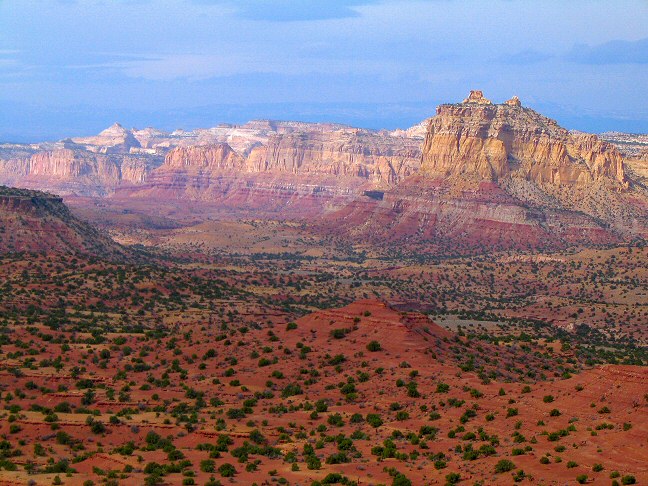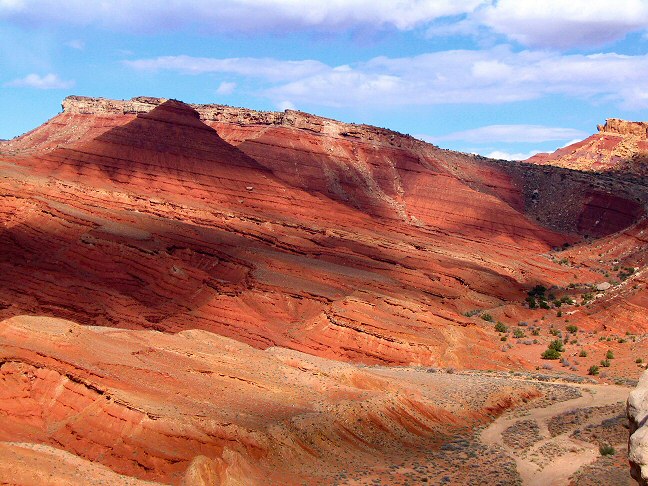The desert is a strange place to live. I call it desert, and then I know that most of you think sand dunes. There's a big difference between desert and dunes. Dunes are boring unless you ride an ATV or are a photographer. Sand. More sand. Sand in piles. Sand in waves. Sand in your shoes. Sand that won't hold your tent stakes. Sand that is home to a few bugs, an occasional whisp of grass, an itinerant population of recreators, and the Sherriff's portable jail trailer on Labor Day weekend.
Desert is different. There is life in the desert. Juniper and pinyon pines dot the landscape. I say dot, because that's what the aerial maps show. Billions of these small trees, but they are not densely packed into the landscape; there is just too much desert out there. Trees need to be spread thin. They don't get an easy start. Maybe there is a series of wet winters to help get the seeds growing. Saplings are rare, not just all the same age, so I doubt plentiful water is the missing factor. The trees in the desert don't block the view.

Fires are rare here too, the fire being unable to spread to any neighboring trees after a lightning strike. Solitary trees, loosely associated, like older suburban homes where you bought more land than the footprint of the building plus six feet on each side, a plot with a front yard and a back yard and a driveway on one side, and enough room for laundry lines on the other, room to breathe. The small trees grow in pairs or singly. Most are alone. They stand on a heap of their old needles. I call them needles because I don't have a better word for them. Juniper "leaves" aren't sharp like the pine needles are, but they form a similar heap at the base of the tree. Small mammals seem to like it there. So do scorpions. It's hard to imagine, when I look at one, that the heap was not there when the tree was young. What happened to the branches on the sapling that were low to the ground, are they still there under the heap, or did they fall away and become part of the heap? When the small blue berries, hard as rock, fall from the juniper, they roll down off the heaps and spread themselves. Self preservation, that's what the trees do.
It's hard not to think of the desert as a person. The skin of the desert is where we stand, but the canyons, the cliffs, speak to a hard life. The desert doesn't cover over its reality, the rock and the scars are always there to see. And you can see some of the damage we humans have done, but most isn't visible any more. Some soils are full of fungus and bacteria, feeding each other, scaley and black. That type of crust is easily killed; walk across it and your footprints stay for a decade. But eventually all traces of your passage are erased. The desert has no interest in preserving the past, and it has wind and rain to help it forget. It has a long life, a slow life, and the hastiness of a vacation can't really disturb it. Even the big dugways, ramps of earth that hug a hillside to gain access to the tops of the plateaus, even those behemoths are gone in 50 years. Made of dirt, they give way to running water. There isn't running water every year, mind, sometimes there is no running water in a decade. But a big storm will come and erase half the roadbed in ten minutes, sending it all down to the wash below. And this it becomes impassable, and without traffic packing the surface, making it resistant to more rain, the rest washes out in ten, twenty more years. Some ATV riders, the braver ones who can control their bikes well, or the dumb ones who have no idea that their bikes can roll, will try the washed-out dugway like a roller coaster ride, but they dig it up more than pack it down. Ten years? Five with a good storm or two?

Plants always survive the desert. They have patience. They are content to drop dozen, dozens, hundreds, thousands of seeds? year after year with no expectation that any of them will germinate. They feed the rodents. But occasionally one will germinate, and maybe even grow to maturity. Some years are fantastic for this. But it's not useful for plant life unless the previous year was one of the rare years when all the plants bloomed well. I've seen one of those years in the desert. It's a surprise if you know the landscape well, and expect to see a few blooms of penstemon, globemallow, and primrose, and one spring you arrive and the entire surface is colored with blooms you've never seen before, red, yellow, pink, mauve, purple, blue, plants you never noticed were there. Seeds in abundance, dropped all over, and some that aren't feeding the rodents and birds find a place to wait. They are patient, like the the rest of the desert.
Rock is patient. Desert rock isn't like the granite of the mountains or back East. It's soft. Sometimes, in what is called the Cutler formation northeast of Moab, it looks like it flows like mud. You'd think that rock was very soft. It isn't. Climbers pound pitons into it and it doesn't crack, it doesn't pull out. it's hard. But it has flowed in the past. it looks like mud. Time, I think, can do many things. Make rock flow like a semisolid seems to be one of them.
The rock is mostly red. Iron compounds that were freed from the basement rocks when there was oxygen in the air all turned red, then they settled into new rock formations. Sandstone formation, anyway. It will weather. The wind and the water will turn it back into sand. That's the time-scale of the desert. We are fleeting bacteria on its skin. It's dealing with rock pushing up from the basement of tome, and wearing down from the action of the wind. Wind destroys rock? If you give it time. It's an artistic process, producing arches, cavities, layers, exposing the flaws when the sediment was laid down, sometimes the waves on the sand when it was laid down. The desert tells you its real past, the long past. It doesn't tell you its immediate past, the time when trees were growing. It doesn't care about your footprints. Those go away in our own lifetimes. What cares the desert of a time as short as man?

The animals of the desert are aloof. Interested in our food, not in us, as it should be. We play in stories, drama, diversions, addictions, none of which have the least interest to a chipmunk. Let them raid the campsite after we are asleep. They have better things to do when we are awake. They have no interest in our world, while we look at theirs with longing. A simplicity of life. Not boring, lurking with large dangers like hawks and coyotes. They have families, but no drama, food but no work, live in a beautiful world they never need to clean. The bigger the animal, the bigger the mess.
Coyotes are messy. Carcasses they find, denude, leave behind for the bugs to finish. Coyotes have family life, too, and I suppose that can get messy. When they howl at night, the soprano howl and yip and whine, irresistible for the rest of the pack and they to join in. A celebration of family in the middle of the night. Wakes up the humans and makes them wonder. Coyotes feel closeness.
I've overlooked canyons, vast landscapes of sand and rock and juniper, smelling the cliffrose rise from the wash below and felt at home there. It wasn't home because the desert welcomed me there; it didn't care, probably didn't know I was there. It was home because I love the rock, and the sand, and the juniper. Petrified wood is my friend, and I recognize it every time it's there. The wind is my friend, and I welcome it. The sun, when the breeze is cold, is my friend and I turn my face to it. Sometimes the sun isn't my friend; it's the desert, but I live with it. Water is my friend. I hoard it. Water is a treasure in the desert. Rain is not my friend. I don't need water outside, I need it in my belly. Rain can turn the painted colors of the Chinle formation, leftovers of volcanic ash, into a mud so slippery you can't stand on it. What good does that do me?
The rock has a name. At least when it's one big rock it does. The tall red cliffs of the Wingate. The wind-carved layer of the Entrada. I've mentioned the mud-flow look of the Cutler. The white hillocks of the Navajo. The mudflat waves of the Moenkopi. Each has a character, the way it feels, the flatness of the rock, the way it sounds when you walk on it, the traction it gives underfoot, the color of it's eroded sand. Formations are like neighborhoods; some friendly, some not; some you get close to , touch, be intimate, some you can't approach.

You can see more photos here.